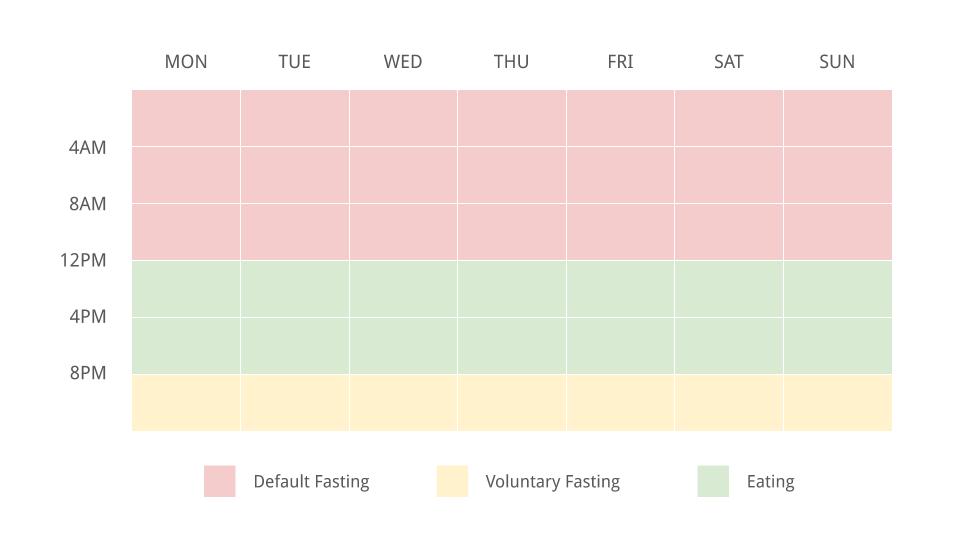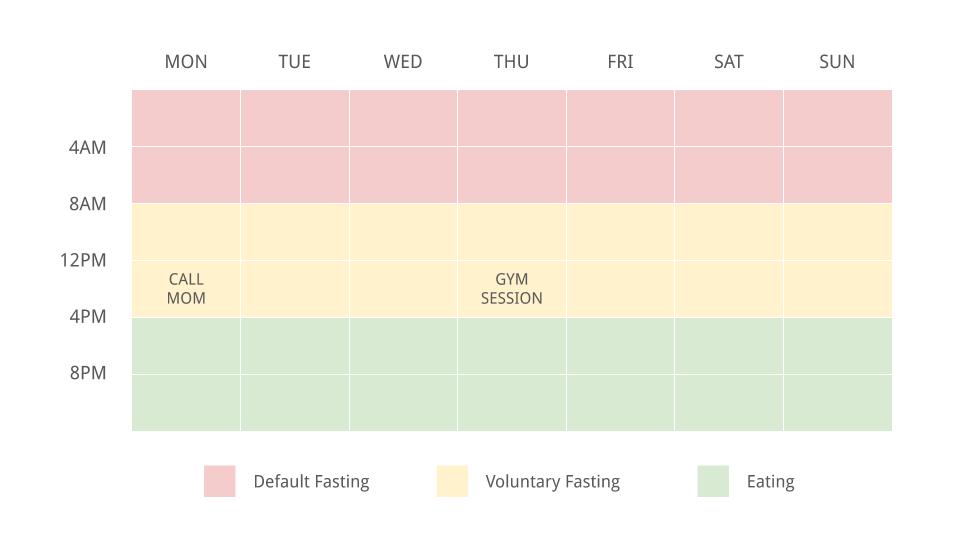When I first heard about intermittent fasting, my reaction was: “Wait, I’ve been doing this for years!” In fact, I have been skipping breakfast for more than fifteen years, simply because I don’t feel hungry in the morning. More recently, I have started experimenting with other intermittent fasting regimens.
Intermittent fasting consists in alternating between non-fasting and voluntary fasting over a given period of time. A fasting period is just when you don’t consume food. By skipping breakfast, I had a 16:8 fasting regimen, where I only ate during an 8-hour window, and fasted for 16 hours.
As noted by Brad Pilon in Eat Stop Eat, previous generations used to eat dinner much earlier than we do today. This pattern resulted in a longer window without eating, which has a host of benefits. I won’t go into the details as this is not a medical website, but this is an excellent and well researched overview.
While fasting is not new—and there is lots of research suggesting that intermittent fasting may help with obesity, inflammation, insulin resistance, and hypertension—you may be wondering if intermittent fasting is compatible with a busy work life. The good news is: yes, it is. In fact, it may even help you be more productive.
Disclaimer: I’m not a physician. The way you eat has a massive impact on your health, and there are many other diets which may be more adapted to you. Do not drastically change your diet without talking to a medical practitioner first.
No one-size fits all
If you start looking up information about intermittent fasting on the Internet, you will read all sorts of contradictory advice. There is practically an infinite number of intermittent fasting regimens, including:
- 16:8 fasting — As I mentioned, fasting for 16 hours and eating all your meals in a 8-hour window.
- 18:6 fasting — A bit more strict, you eat all your meals in a 6-hour window.
- Alternate day fasting — A regimen when you fast every other day. It could be described as a 36:12 fast.
- OMAD — The self-explanatory “one meal a day”, which for most people using this regimen is dinner.
- 5:2 diet — Eat normally for five days a week, and drastically reduce your calorie intake for two days each week.
- Weekly fast — Don’t eat anything for one day a week. Sunday is a popular option.
There is also 20:4 fasting, circadian rhythm fasting, and the list goes on. It’s easy to get lost. And, of course, proponents of each fasting method will tell you their approach works best. But for who?
Design your intermittent fasting schedule around your work habits
Instead of blindly following the advice of some Internet stranger—or worse, pick a random fasting regimen without giving it any thought—it’s better to experiment and to choose an approach that fits around your work habits.
For instance, if you are an early bird and tend to go to bed early, it may make more sense to skip dinner rather than breakfast. If lunch with your team is an important part of your company culture, you may not want to skip it. And if you wake up late, it may be easier to skip breakfast.
In order to design a mindful intermittent fasting schedule, I found it helpful to look at my “default fasting hours”—the times when I’m effortlessly fasting because I’m engaged in another activity (including sleeping) or usually not hungry. By shifting a few things around, most people would manage to get to a 16:8 fasting schedule without forcing themselves too much.

In addition, ask yourself: when do I need the most mental clarity? While the first few days of intermittent fasting may make you feel a bit foggy while your body adapts, many people report better mental clarity after a while. In fact, there’s even research showing improved cognitive functions and brain structures in mice following an intermittent fasting diet.
However, post-meal sleepiness is a common phenomenon caused by a dramatic increase of blood flow to the small intestine after we eat—and, while some kinds of diets rich in vegetables and healthy fats may minimise this phenomenon—it won’t completely go away with intermittent fasting. Looking at your work schedule and when you need to be most productive can help in deciding on an intermittent fasting plan.
You can skip lunch and still take a lunch break
Taking breaks at work is crucial to stay productive, to be more creative, and to take care of your mental health. A mistake some people make when trying to turn intermittent fasting into a productivity hack is to work through their lunch break.
While skipping your break may give you a temporary feeling of productivity, it won’t be sustainable in the long run. Studies show that brief mental breaks help keep you focused and enhance your overall performance.
Not eating at lunchtime doesn’t mean you have to skip your break. On the contrary, not having to sit down and eat a meal frees up time to do something else: a short walk, a gym session, a grocery run, a quick nap, a call with a friend or family member.
You can even create rituals around your lunch breaks by blocking time for such activities. For instance, call your parents every Monday while taking a walk in the neighbourhood.

Please note: if you wake up extremely early with a goal to be done with work by around 2pm, this still applies. Everyone needs to take breaks. Yours may just be a mid-morning break instead of a lunch break.
Don’t overcomplicate it
Beside the health benefits, one of the key advantages of intermittent fasting is the simplicity. A friend told me: “What I like most is to have one less meal to worry about every day.” This simplicity can free your mind to focus on other activities. So don’t replace this newfound freedom with overcomplicated rules and a stressful regimen.
For instance, some purists may tell you to not drink any tea or coffee during your fasting windows, and to stick to water. I drink lots of unsugared tea while fasting, because that’s something I enjoy doing. You don’t have to be drastic when following an intermittent fasting diet.
It’s okay to break a fast earlier than expected. You may have had a late night out with friends, and the lack of sleep impacts your energy levels. Don’t force yourself to wait until the end of your fasting window if you are starving and can’t get any work done.
Intermittent fasting cannot replace basic health habits, such as drinking enough water, exercising, and getting enough sleep. Despite what you may have read from productivity gurus, it is not a magical solution that will solve all of your productivity challenges either.
However, intermittent fasting can fit into a busy work schedule, and it doesn’t have to negatively impact your productivity levels. Just be mindful of the way you design your fasting plan, and make it as easy as possible to stick to.
